

|
 Soft fruit-flavoured coloured jelly sweets in the shape of plump babies, approx 1 in high. BBC - Fyfe Robertson discovers the history of JB, 1965 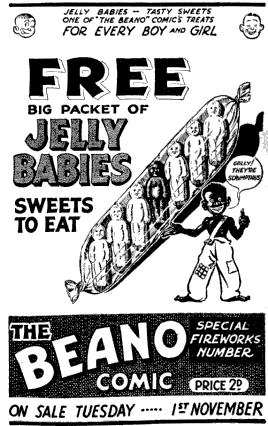 Advertisement from The Dundee Courier, 31 October 1938 Edible treats of various sorts in the shape of babies appear from time-to-time through the centuries, as with the English Yule Bread Babies, and the sugar-fondant babies given as wedding gifts in 19th Century Italy and France, though these were all doll-like, much larger and quite different to the tiny jelly sweets known now. 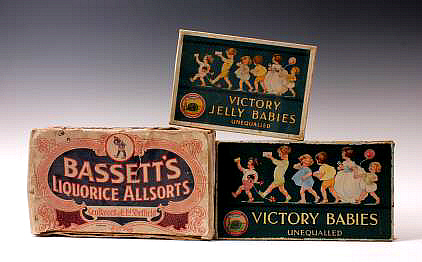 Early 20th Century packaging, 'Victory Jelly Babies' by T F & Co. Image: www.bamfords-auctions.co.uk 'Jelly Babies' are first known from advertisements by Riches Confectionery of 22 Duke St, London Bridge in 1885, along with a variety of other baby-sweets including 'Tiny Totties' and 'Sloper's Babies' (Ally Sloper was an immensely popular cartoon comic character), which were described as 'all ready dressed', and, at the high price of a farthing each (wholesale) must have been quite large, as, relating to the cost of other sweets they weighed about 1oz each, making them perhaps 2 or 3 ins long. 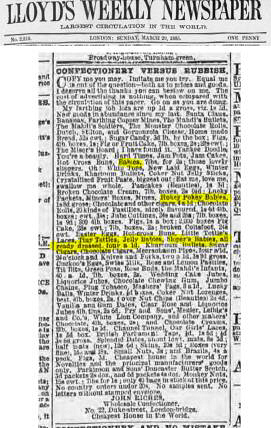 Earliest known advertisement for Jelly Babies Lloyd's Weekly, March 23, 1885 It is not entirely clear where the modern, tiny, jelly, form of Jelly Baby originated. They appear in wholesaler's catalogues from the 1920's and were certainly manufactured around that time by Thomas Fryer of Nelson in Lancashire under their 'Victory' brand (as in the famous Victory 'V' Lozenges). 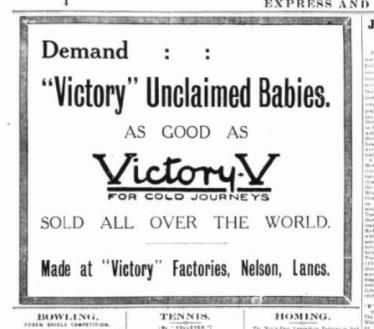 Burnley Express - Saturday 17 August 1929 Fryer's also produced 'unclaimed babies', which may predate JB's, and seem to have been hugely popular in the early 20th Century. The 'Burnley Express' reported on 16th December 1939 that, of all the comforts sent to troops abroad; "the sweets which are in greatest demand are those which we all know as 'unclaimed babies'. Over 50 pounds of these sweets have already been purchased". The most noted manufacturer of modern Jelly Babies, the Bassett Company of Sheffield, have been manufacturing them since the 1950's. Bassett's, now owned by Mondelez International, produce some one thousand million each year, and, since 1989, have allocated names to the different colours of Baby: Bonny- pink, Boofuls- blue, Bumper- green, Bubbles- yellow, Big Heart- grey, Brilliant- red. If a Jelly Baby is added to hot Potassium chlorate, the baby oxidises very rapidly, emitting a screaming sound. This 'Screaming Jelly Baby' experiment is considered so exciting that it has not only often formed the centrepiece of school science demonstrations but has even been used by HM Government to try and attract chemists into teaching. Can you help? editor@foodsofengland.co.uk There are two, much-repeated, stories about the history of Jelly Babies we can't get to the bottom of: 1: That baby sweets were devised by an Austrian called Steinbeck (or Steinboch, Sprongbok), at Fryers of Nelson around 1864, but we can't trace that any further back than 'Sweets: The History of Temptation' by Tim Richardson of 2002. 2: That a type of sweet similar to JB's were introduced after the First World War as 'Peace Babies', though we can find no contemporary reference to this. 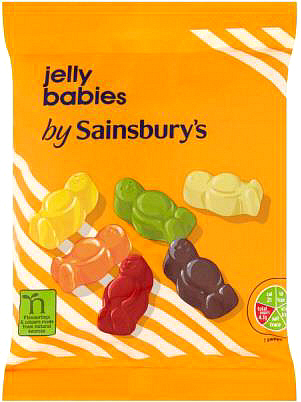 2014  |
|
MORE FROM Foods of England... Cookbooks ● Diary ● Index ● Magic Menu ● Random ● Really English? ● Timeline ● Donate ● English Service ● Food Map of England ● Lost Foods ● Accompaniments ● Biscuits ● Breads ● Cakes and Scones ● Cheeses ● Classic Meals ● Curry Dishes ● Dairy ● Drinks ● Egg Dishes ● Fish ● Fruit ● Fruits & Vegetables ● Game & Offal ● Meat & Meat Dishes ● Pastries and Pies ● Pot Meals ● Poultry ● Preserves & Jams ● Puddings & Sweets ● Sauces and Spicery ● Sausages ● Scones ● Soups ● Sweets and Toffee ● About ... ● Bookshop ● Email: editor@foodsofengland.co.uk COPYRIGHT and ALL RIGHTS RESERVED: © Glyn Hughes 2022 BUILT WITH WHIMBERRY |